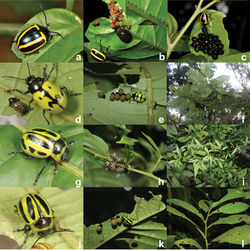Proseicela vittata
| Notice: | This page is derived from the original publication listed below, whose author(s) should always be credited. Further contributors may edit and improve the content of this page and, consequently, need to be credited as well (see page history). Any assessment of factual correctness requires a careful review of the original article as well as of subsequent contributions.
If you are uncertain whether your planned contribution is correct or not, we suggest that you use the associated discussion page instead of editing the page directly. This page should be cited as follows (rationale):
Citation formats to copy and paste
BibTeX: @article{Windsor2013ZooKeys332, RIS/ Endnote: TY - JOUR Wikipedia/ Citizendium: <ref name="Windsor2013ZooKeys332">{{Citation See also the citation download page at the journal. |
Ordo: Coleoptera
Familia: Chrysomelidae
Genus: Proseicela
Name
Proseicela vittata (Fabricius, 1781) – Wikispecies link – Pensoft Profile
Remarks
Female Proseicela vittata (Fig. 3a) were observed by D.W. tending offspring during each of three visits to Montagne de Kaw, French Guiana (elevation 150 m; 4°32.686'N, 52°09.151'W), 11–18 April 2010, 25–31 January 2011 and 19 June–2 July 2012. All individuals and family groups were found on a single species of host plant, Solanum morii S. Knapp, a 1-3 m shrub with glabrous leaves and pendulous green and white fruit and a colonist of disturbed areas (Plate 121a, Mori et al. 2002[1]). We searched host plants for this species mainly along logging roads. While numerous individuals and family groups were found on each trip, most groups contained older larvae. Only four females were found tending recently deposited larvae, 11 to 18 in number, which had not begun to feed. The brood tended by one female contained a single large larva feeding and resting beside 17 freshly deposited larvae (Fig. 3b). Within 2 days the single large larva descended alone to pupate, a sign that while broods may overlap in this species (as in Platyphora microspina) the period of overlap is brief. Normally, individual larvae within cohorts were remarkably similar in size (Fig. 3c). The only exception came if they were observed on day 2 or 3 while molting was in progress. Despite three observation periods per day of approximately 15 min per family, possible predators and parasitoids were rarely observed. And while a Pachycondyla ant or a carabid beetle may have been responsible for the abrupt loss of 15 of 17 larvae from one female over night, ongoing predation has yet to be observed in this species. The 17 larvae belonging to another female were observed to take approximately 30 hours to consume the entire lamina of the natal leaf. While the last of the leaf was being consumed some larvae began to molt while still on the remnants of the natal leaf. The mother maintained a tight grip on the leaf petiole (blocking behavior), but eventually larvae pushed by and began traversing nearby stem and petioles solitarily or in small groups. Commonly families split into two or more separated feeding groups at this stage, with the mother usually remaining with a larger group. Groups often reunited but others remained separated until pupation. The transition from the natal to second leaf appears to be a crucial and dynamic time for larvae and events proceeded differently for most groups. During this period mothers moved actively among different leaves and branches in what seemed to be attempts to herd and reconstitute a single larval group. While we observed what we interpret as herding behavior in most species in this report, its possible importance to group safety and success remains open and in need of experimental study.
Taxon Treatment
- Windsor, D; Dury, G; Frieiro-Costa, F; Susanne Lanckowsky, ; Pasteels, J; 2013: Subsocial Neotropical Doryphorini (Chrysomelidae, Chrysomelinae): new observations on behavior, host plants and systematics1 ZooKeys, 332: 71-93. doi
Other References
- ↑ Mori S, Cremers G, Gracie C, de Granville J, Heald S, Hoff M, Mitchell J (2002) Guide to the vascular plants of central French Guiana: Dicotyledons, part 2. Memoirs of the New York Botanical Garden, New York, NY, 776 pp.
Images
|
